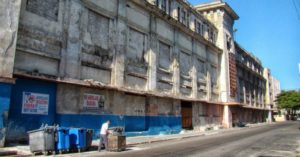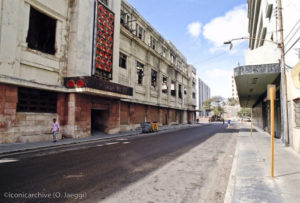“MOSCÚ RESTAURANT” AND “CABARET MONTMARTRE” IN HAVANA, CUBA. WHAT ONE DAY THEY WERE. PHOTOS
As an inescapable metaphor for the fall of the Soviet Union itself, this is the old and famous Moscow restaurant, located in the heart of the Havana Ramp. The building that had previously been the cradle of the brand new Montmartre cabaret, an iconic nightclub of the 40s and 50s in Cuba, which was visited by great stars of the entertainment world such as Edith Piaf, Cab Calloway or Nat King Cole, and in which even Ava Gardner and Frank Sinatra tasted a complimentary wedding cake while enjoying their honeymoon in Cuba in 1947.
After the coming to power of Fidel Castro and the nationalizations that followed, the building ceased to house the famous casino and cabaret Montmartre. In the late 1960s, the place was renamed Moscow, a nod to the Soviet Union. The bolero nights came to an end and the space was occupied by dishes of Russian origin, such as Pelmeni, Shashlyk, Borsch, and Uja; the house specialty being the “Salianska soup”, made with copious pieces of meat that gave it such a particular taste that even Russian cooks had to remove their hats.
Only in the memory of many Cubans will those days of glory remain in which that construction set in its interior in the tsarist style
“It was one of the best places to eat in Havana and they had employees trained in the old way, who treated customers with kindness and without the freshness of today,” recalls Ernesto Fiallo, a neighbor of Calle O, nearby. of the place
A fire that occurred in 1989, which many say was intentional, sealed the fate of the place. According to witnesses, the fire did not start inside the restaurant itself, but in a neighboring company called ABATUR. The wooden floor of the restaurant had been raised to be changed, which is why a fairly large hole remained that allowed that from the upper floor of ABATUR, Moscow could be seen through the ceiling of an office that remained closed due to construction. that they were making upstairs and that a drinking fountain in the dining room of the restaurant workers fell a drop downwards, which in contact with electrical cables in the wall could cause the short circuit that started the wildfire. There it has remained, subjected for decades to institutional neglect and neglect.
The advanced state of deterioration that the property shows today has been the subject of conversation in the Assemblies of Accountability of the People’s Power.
RESTAURANT MOSCÚ WHAT A DAY WAS
The place remains closed, with bricked-up doors and windows and with strong vegetation emerging from between its walls. The residents of the neighborhood are the ones who have had to suffer the immense amount of mosquitoes generated by the humidity of the abandoned building.
Given the damage that accumulates for decades inside its ruins, the authorities warned that it was insurmountable, and there were no possibilities for its salvation. Only the operation to dismantle the building would take about 4 million pesos, in terms of the 260 cubic meters of wood for the shoring and no less than two cranes employed full time for a year, so this is not a priority within the city’s investment plan.
Other structures in worse condition have been restored in Old Havana, but Moscow seems to carry some kind of curse, as it was there that Antonio Blanco Rico, head of Fulgencio Batista’s Military Intelligence Service, was assassinated.
In a sad lethargy, that majestic building continues that survives in the memory of Cubans and Havanans.
Turned into a spontaneous citadel, a public bathroom, and a source of mosquitoes, mice, and all kinds of vectors, the surrounding residents complain about the growing deterioration and the lack of actions so that such a central corner of Vedado has better fortune.
“They wanted to demolish it to make a hotel, in that nonsense that they always are,” highlights a neighbor. And she finishes another: “They say they are going to build a five-star hotel!”
However, sadly after more than three decades of the accident that invalidated it, despite the efforts of the national press to unleash a quick solution, everything returns to normal: the silence of what no one knows will happen returns.
“RESTAURANTE MOSCU” Y “CABARET MONTMATRE” EN LA HABANA, CUBA. LO QUE UN DIA FUERON. PHOTOS.
Como ineludible metáfora de la caída de la propia Unión Soviética, así ha quedado el antiguo y famoso restaurante Moscú, sito en pleno corazón de la Rampa habanera. El edificio que previamente había sido la cuna del flamante cabaret Montmartre, icónico club nocturno de los años 40 y 50 en Cuba, que fue visitado por grandes estrellas del mundo del espectáculo como Edith Piaf, Cab Calloway o Nat King Cole, y en el que incluso Ava Gardner y Frank Sinatra degustaron una tarta nupcial de cortesía, mientras disfrutaban de su luna de miel en Cuba, en 1947.
Tras la llegada al poder de Fidel Castro y las nacionalizaciones que se sucedieron, el inmueble dejó de albergar el famoso casino y cabaré Montmartre. A finales de la década de los 60 el lugar fue rebautizado como Moscú, un guiño a la Unión Soviética. Las noches de bolero llegaron a su fin y el espacio quedó ocupado por platos de origen ruso, como el Pelmeni, Shashlyk, Borsch y Uja; siendo la especialidad de la casa la “sopa Salianska”, elaborada con copiosos trozos de carne que le daban un gusto tan particular, que hasta los mismos cocineros rusos debían quitarse el sombrero.
Solo en el recuerdo de muchos cubanos quedarán aquellos días de gloria en que esa construcción ambientada en su interior al estilo zarista
“Era uno de los lugares donde mejor se comía en La Habana y tenían empleados formados a la vieja usanza, que trataban a los clientes con amabilidad y sin la frescura de ahora”, recuerda Ernesto Fiallo, vecino de la calle O, en las cercanías del lugar
Un incendio ocurrido en el año 1989, que muchos aseguran que fue intencional, selló la suerte del lugar. Según cuenta los testigos, el fuego no se inició dentro del propio restaurante, sino en una empresa contigua llamada ABATUR. El piso de madera del restaurante había sido levantado para ser cambiado, razón por la que quedaba un orificio bastante grande que permitía que desde el piso superior de ABATUR, se podía ver el Moscú a través del techo de una oficina que permanecía cerrada por las obras que arriba realizaban y que un bebedero en el comedor de los obreros del restaurante caía una gota hacia abajo lo que al contacto con cablees eléctricos en la pared pudo provocar el corto circuito que iniciara el fuego arrasador. Allí ha quedado, sometido durante décadas al abandono y a la desidia institucional
El avanzado estado de deterioro que muestra el inmueble en la actualidad ha sido tema de conversación en las Asambleas de Rendición de Cuentas del Poder Popular.
RESTAURANT MOSCU LO QUE UN DIA FUE
El local permanece clausurado, con puertas y ventanas tapiadas y con fuerte vegetación emergiendo de entre sus muros. Los vecinos del barrio son los que han tenido que sufrir la inmensa cantidad de mosquitos que genera la humedad del edificio abandonado.
Ante los daños que acumula por décadas al interior de sus ruinas, las autoridades advirtieron que era insalvable, y no existían posibilidades para su salvación. Solo la operación de desmantelar el edificio se llevaría unos 4 millones de pesos, en términos de los 260 metros cúbicos de madera para el apuntalamiento y no menos de dos grúas empleadas a tiempo completo por un año, por lo que esto no constituye una prioridad dentro del plan de inversiones de la ciudad.
Otras estructuras en peor estado han sido restauradas en la Habana Vieja, pero el Moscú parece arrastrar algún tipo de maldición, como que fue allí donde asesinaron a Antonio Blanco Rico, jefe del Servicio de Inteligencia Militar de Fulgencio Batista.
En un letargo triste continúa ese majestuoso edificio que sobrevive en la memoria de los cubanos y habaneros.
Convertido en espontánea ciudadela, en baño público y en fuente de mosquitos, ratones y todo tipo de vectores, los vecinos de los alrededores se quejan del creciente deterioro y de la falta de acciones para que una esquina tan céntrica del Vedado, tenga mejor fortuna.
“Querían demolerlo para hacer un hotel, en esa bobería que siempre están”, destaca una vecina. Y remata otra: “¡Dicen ellos que van a hacer un hotel cinco estrellas!”.
Sin embargo, tristemente después de más de tres décadas del siniestro que lo invalidó, a pesar de los esfuerzos de la prensa nacional en desatar una solución rápida, todo vuelve a la normalidad: retorna el silencio de lo que nadie sabe qué sucederá.
Agencies/ CiberCuba/ Extractos/ Excerpts/ Internet Photos/ Arnoldo Varona/ www.TheCubanhistory.com
THE CUBAN HISTORY, HOLLYWOOD.












